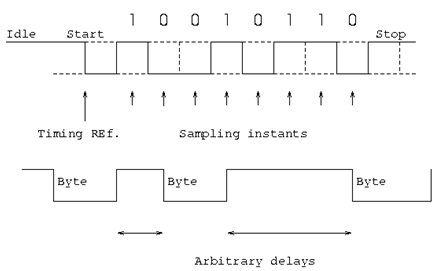Transmission Techniques:
1. Asynchronous: Little blocks of bits (generally bytes) are sent at a time without any time relation among successive bytes. When no transmission occurs a default state is maintained equivalent to bit 1. Due to arbitrary delay between successive bytes, the time occurrences of the clock pulses at the receiving end need to be matched for each byte. This is achieved by giving 2 extra bits start and stop.
Start bit: It is prefixed to each byte and equals zero. Thus it ensures a transition from 1 to 0 at onset of transmission of byte.Here,the leading edge of start bit is used as a reference for generating clock pulses at necessary sampling instants. Therefore each onset of a byte results in resynchronization of receiver clock.
Stop bit: To ensure that transition from 1 to 0 is always present at beginning of a byte it is essential that default state be one. But there may be two bytes one immediately following the other and if last bit of first byte is 0 then transition from one to zero will not occur. for that reason a stop bit is suffixed to each byte equalling one. It's duration is typically 1,1.5 and 2 bits.
Asynchronous transmission is simple and cheap but requires an overhead of 3 bits i.e. for 7 bit code 2 (start, stop bits) +1 parity bit implying 30% overhead. However % can be reduced by sending larger blocks of data but then timing errors between receiver and sender cannot be tolerated beyond [50/no. of bits in block] % (assuming sampling is done at middle of bit interval). It will not only end result in incorrect sampling but also skewed bit count i.e. a data bit could be mistaken for stop bit if receiver's clock is faster.

2. Synchronous - bigger blocks of bits are successfully transmitted. Blocks of data are either considered as sequence of bits or bytes. To avoid timing drift clocks at two ends need to be synchronized. This can done in 2 different ways:
1. Provide a separate clock line between receiver and transmitter. OR
2. Clocking information is embedded in data signal to be precise biphase coding for digital signals.
Still another level of synchronization is required so that receiver determines beginning or end of block of data. thus each and every block begins with a start code and ends with a stop code. These are in generally known as flag that is exclusive sequence of fixed number of bits. In addition some of control characters encompass data within these flags. Data+control information is called a frame. Since any arbitrary bit pattern can be transmitted there is no assurance that bit pattern for flag will not appear inside the frame thus destroying frame level synchronization. For avoiding this we use bit stuffing
Bit Stuffing: Suppose our flag bits are 01111110 (six 1's). So the transmitter will always insert an extra 0 bit after each occurrence of five 1's (except for flags). After detecting a initial flag the receiver monitors the bit stream. If pattern of five 1's occurs, the sixth is examined and if it is 0 it is deleted else if it is 1 and next is 0 the combination is accepted as a flag. in the same way byte stuffing is used for byte oriented transmission. In this we can use an escape sequence to prefix a byte similar to flag and 2 escape sequences if byte is itself a escape sequence.

Email based Computer Science assignment help - homework help at Expertsmind
Are you searching Computer Science expert for help with Transmission Techniques questions? Transmission Techniques topic is not easier to learn without external help? We at www.expertsmind.com offer finest service of Computer Science assignment help and computer science homework help. Live tutors are available for 24x7 hours helping students in their Transmission Techniques related problems. We provide step by step Transmission Techniques question's answers with 100% plagiarism free content. We prepare quality content and notes for Transmission Techniques topic under computer science theory and study material. These are avail for subscribed users and they can get advantages anytime.
Why Expertsmind for assignment help
- Higher degree holder and experienced experts network
- Punctuality and responsibility of work
- Quality solution with 100% plagiarism free answers
- Time on Delivery
- Privacy of information and details
- Excellence in solving computer science questions in excels and word format.
- Best tutoring assistance 24x7 hours